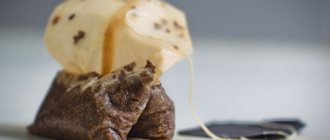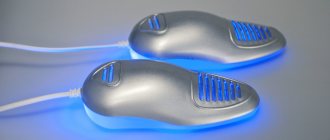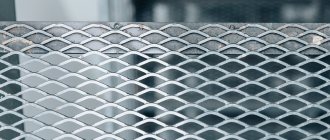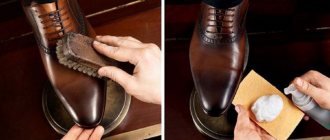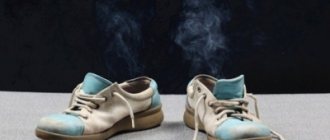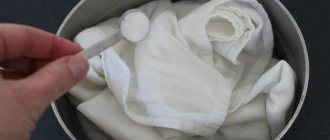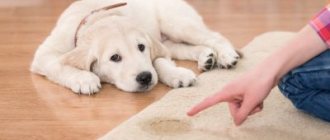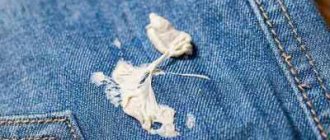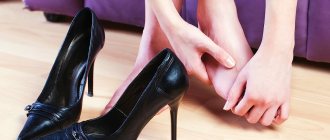Author: IsTOPnik
November 18, 2022 10:10
Community: Idea Factory
Tags: Unpleasant smell from shoes smell from shoes smells shoes tips photos tricks
45948
8
1
An unpleasant odor from shoes can be felt not only after prolonged use, but even from a new pair that has not yet been worn.
0
Source:
See all photos in the gallery
In most cases this is a solvable problem. You can use not only special products, but also simple home recipes. We'll tell you more about how to remove the smell of sweat, dampness and other unpleasant odors from shoes at home in this article.
Causes of unpleasant amber
0
Source:
There can be several reasons for the unpleasant odor from shoes. The most common include: improper care of the pair, which is why fungi and bacteria grow in the shoes; some dermatological diseases of the skin of the legs; sewing shoes from low-quality materials; pet urine; improper use of a specific pair (for example, wearing rubber boots for a long time in the heat, etc.) and some other circumstances. Most causes can be eliminated. But there are also those that are almost impossible to cope with. This statement can be applied to shoes that are made of materials that emit an unpleasant odor. For the most part, these are very cheap materials that unscrupulous manufacturers use. It is unlikely that it will be possible to completely remove the specific aroma from such a pair.
How to get rid of odor from shoes: a review of available products
To cope with the “stinking problem”, products that can be found in the kitchen or purchased at a store or pharmacy will help. If you can’t remove the odor from sweat from your shoes the first time, repeat the procedure. And don’t forget to ventilate your shoes well after treatment.
Products from the kitchen
There are a number of products available in the kitchen that can help remove odor from shoes. And their bactericidal properties will also destroy bacteria and microbes. Here are the six most used remedies.
- Vodka. Pour vodka into boots, shoes, put on socks, and walk around until the alcohol evaporates. Then place the pair of shoes on the balcony to air out. There will be no trace left of the stinking “aroma”.
- Green tea or coffee. Place a used tea bag under the insole or sprinkle some leaves into each shoe. Tea neutralizes bad odors and has an antibacterial effect. Scattered coffee granules will give your shoes a pleasant aroma.
- Vinegar. Moisten cotton wool with a 9% vinegar solution, wipe the boots, then put them out in the fresh air to air. The solution will remove the unpleasant odor and kill harmful bacteria and fungus.
- Salt or soda. Pour table salt into your sneakers and leave for one night. This universal product will absorb moisture and nasty odors. You can do the same thing with baking soda, but use it for light-colored shoes. Remove excess powder from the sneakers using a vacuum cleaner.
- Corn starch. Sprinkle it under your shoe insoles overnight. It absorbs moisture well and removes old miasma of sweat.
- Citrus peels. Place fresh orange and lemon peels inside your shoes. Overnight, the shoes will be saturated with them and will smell fresh.
Cat litter will also cope with the unpleasant odor from sneakers, because its main function is to fight odors. In addition, if you pour filler granules into a sock and put it inside wet sneakers, then in the morning they will be completely dry.
Pharmacy drugs
Check your home first aid kit and you will find at least one of these remedies. And if not, then you can buy them at the pharmacy for literally pennies. The ten pharmaceutical products listed below have the necessary effect.
- Hydrogen peroxide. Moisten a cotton pad with a 3% solution and wipe the inside of the sneakers. Then dry them well. Peroxide is suitable for treating sneakers to prevent the development of fungus. The solution may lighten the dark surface of the shoes, so only use it on light-colored shoes!
- Potassium permanganate. Dissolve two manganese crystals in 150 ml of warm water, wet the disc, wipe the inside of the shoe, and dry.
- Talc. Sprinkle the inside of your shoes with talcum powder and leave overnight. Vacuum the next morning - the talc will absorb moisture.
- Activated carbon. Place a few tablets in your boots at night. The sorbent will absorb bad aroma and moisture. Keep in mind that charcoal may leave dark stains when processed - use it for black shoes.
- Tea tree oil. Soak a cotton pad in ether and wipe the inside of the sneakers. Ether vapors will help cope with ingrained sweat odor and disinfect insoles and fabric.
- Ammonia. Dilute one tablespoon of ammonia in a glass of water and wipe the contaminated areas on the shoes with it.
- "Formidron". Apply the product to a cotton pad and wipe the inside walls of the shoes. Then wrap the shoes in cellophane and leave for 12 hours. Formidron will not only get rid of the stinking amber, but will also serve as a preventive measure for foot fungus. Be careful - it contains formaldehyde, so use gloves when handling.
- Alum. Place white powder crystals under the lining of your shoes. In the morning, remove excess with a napkin. The remaining powder under the lining will act as a deodorant. This is a great way to get rid of odor in sneakers.
- Lavender oil. Drop lavender onto a sponge and wipe the inside of your shoes. This is an antibacterial attack, since the ether not only has a pleasant aroma, but also kills microorganisms and mold.
- "Chlorhexidine." Take a solution of 1% concentration and moisten a cotton pad with it. Wipe the inside of all shoes thoroughly. Place the purified pair in a bag and leave for several hours. Then dry thoroughly in fresh air. Chlorhexidine is a powerful odorless and colorless antiseptic that kills various dermatitis and bacteria. Absolutely safe in contact with skin.
Regular foot baths can reduce excessive sweating of the feet. The main ingredients can be sea salt, soda, green tea, citric acid, oak bark.
Professional "helpers"
If you do not want to experiment with traditional methods, then store-bought products will help solve the problem. They contain tannins and antiseptics, which reduce sweating and stop the proliferation of harmful microorganisms. But you can get rid of the unpleasant odor from shoes if you apply them to already cleaned sneakers or shoes. According to their type and method of influence, they are divided into:
- deodorants;
- ointments, creams;
- pills;
- pencils (sticks);
- insoles.
Deodorants are easy to use and suitable for daily use. The shoe odor remover should be sprayed onto the clean skin of the feet and wait until it dries. They come in four types.
- Antiperspirants. They block the work of the sebaceous glands, so they cannot be used constantly.
- Normalizing deodorants. Reduces the activity of the sebaceous glands, causing the feet to sweat less.
- Therapeutic deodorants. They do not fight the smell, but the cause of its occurrence, bacteria.
- Sprayers for shoes. The product in the form of an aerosol removes odor using various fragrances. You need to spray inside the boots and wait for it to dry. The validity period is several days.
Other store “helpers” also effectively affect the causes of odors. Here are four of the most well-known remedies.
- Ointment. It is considered the most effective assistant in the fight against sweating. It is quickly absorbed and has a longer effect, unlike a spray. Pleasantly softens and moisturizes the skin of the feet, suitable for daily use.
- Pills. Leave in shoes overnight. They have a good effect and excellent reviews, but are not cheap.
- Sticks. Available in the form of a thick pencil, they remove bad odors, but they are inconvenient to use. One careless movement during processing, and the special rod will break.
- Insoles. They come with a base of silica gel or activated carbon. Helps keep shoes fresh for a long time.
Alternative Methods
All means are good for removing unpleasant odors from your favorite boots. But it’s not always possible to wash or treat shoes to remove odor, and you don’t want to see mold and mildew appearing on your shoes. Then alternative methods come to the rescue. Here are three of the most popular.
- Low temperature. Wrap the shoes in a plastic bag and put them in the freezer for several hours. In winter, in order not to occupy the freezer, a couple can be placed on the balcony. This method will help eliminate odor in shoes with fur. The cold will kill all microorganisms, and therefore the winter pair will be as good as new.
- Wash. If the material allows, then wash the sneakers on a delicate cycle in the machine. Then dry them well, since the favorite environment of bacteria is moisture.
- Steam generator. Turn on the device and spray the inner walls of the shoes and insoles with a stream of hot air.
The freezing method is not suitable for patent leather. It can crack from low temperatures.
Alcohol
0
Source:
To treat the inside of the shoe, vodka or alcohol diluted with water can be used. The method of applying the selected drug depends on the shoe model. If possible, wipe the inner surface of the pair with a sponge soaked in vodka. When this is difficult to do, it is better to pour the alcohol-containing liquid into a spray bottle. After the inside of the pair has been processed, it must be given time to simply stand for 3-4 hours. Areas treated with vodka are wiped with paper towels, after which the shoes are left to dry completely.
Additional recommendations
After the shoes have been cleaned and the unpleasant odor has been eliminated, it is important to keep the shoes clean and prevent the reappearance of “odors”:
- After wearing, leave the shoes open: the tops of the boots and the lacing of the shoes should open the inner surface as much as possible so that it has time to ventilate and dry before putting it on.
- It is recommended to have at least two pairs of shoes, which can be alternated every other day: the shoes will have time to “rest” and air out.
- Worn, uncleaned shoes should not be put into boxes for long-term storage: dirt should be removed and allowed to air out.
- A favorite way for some men is to kill two birds with one stone by stuffing their socks into their sneakers immediately after wearing them: a recipe for odor and creating an unventilated environment for germs to breed.
- And socks: it’s better if they are made from natural materials: synthetics in any form disrupt natural ventilation, increase sweating and give rise to a pungent odor.
Clean outside and inside men's boots
How to wash winter boots, combat boots, boots or ankle boots can be found out when purchasing these shoes in a store. Even professional-quality shoes require proper and regular care: regular cleaning and care of both the outer surface of shoes, boots, slippers and sports sneakers, as well as the inner surface, will extend the life of the shoes and save money, providing a healthy and beneficial microclimate for the feet.
Using soda
0
Source:
Treating with soda is a good option for those shoes whose insides cannot be wet. This method can be used, for example, to care for winter boots. Application: pour a tablespoon of soda into each shoe; the powder needs to be well distributed over the insole - do this conveniently with shaking movements; put the pair in a plastic bag; leave for 5 hours; shake out the soda. Instead of soda, you can use kitchen salt in the same way.
Wash more often
Of course, not all shoes can be washed in a washing machine, but textile ones, as well as rubber or plastic flip-flops, are encouraged to be washed in a washing machine. This way it can be cleaned in a way that you couldn’t do manually. Remove insoles and wash them, except leather ones, to get everything as clean as possible.
If you are not sure whether this action is permissible with a particular pair, be sure to read the care and cleaning instructions. The delicate wash mode will withstand any shoes that can be washed.
Insoles that are heavily soiled are first wetted and soaped with laundry soap, left to soak the dirt, and then rubbed with a brush or hard sponge before washing to remove trampled stains.
To safely machine wash our boots, you will need a pillowcase and detergent.
Remove laces before washing. Place the shoes in a pillowcase and then transfer the pillowcase to the washing machine. One cycle may not be enough if the odor is strong. You may have to run very smelly crosses through two cycles.
For disinfection: if the shoes and insoles are white, it is permissible to add a little chlorine bleach to the regular detergent; for dark or colored shoes - 100-300 ml of 9% vinegar.
For bright or dark colors, this method of removing odor before washing is suitable:
Fill each shoe with one cup of baking soda. Then add a cup of vinegar. This will cause the baking soda to bubble. Let the mixture sizzle for about 15 minutes. After this step, we finish the cleaning process by machine washing.
After washing, allow the shoes to air dry.
It is not advisable to use a dryer, since forced hot drying can lead to shrinkage of shoes.
SmellOff
0
Source:
SmellOff TM odor eliminator can be used to treat sports equipment, shoes and other surfaces with the odor of sweat. The drug has a neutral composition and does not pose a health hazard. When used correctly, odors are completely neutralized. Application: Clean shoes from dirt. If the insoles are removed, they must be washed separately. Using a spray bottle, apply the product to the inside of the shoes. Leave to stand in a dry place for up to 24 hours. Price – about 670 rubles per 0.5 liter.
If the shoes are “marked” by the cat
The cause of the pungent odor can be the tricks of your beloved pet. The biggest catch is that the smell of cat urine is very persistent and difficult to remove; water does not affect the uric acid crystals. What can I do to prevent my shoes from smelling in this case? Treatment must begin immediately and be carried out very carefully. If you leave even a drop of sticky urea, the slightest wetting and bad aroma will return again. The algorithm of actions includes five steps.
- Inspection. Throw away your insoles; most of the urine accumulates on them.
- Wash. If the shoes are made of fabric materials, then wash them with glycerin soap.
- Wiping. Genuine leather does not tolerate washing, so treat it with a solution of potassium permanganate. Dilute several manganese crystals per liter of water, wipe the boots well, then dry and ventilate.
- Drying. If your urine smells old, use acetic acid. Mix water and vinegar in equal proportions, wipe the shoes and cover the wet areas with baking soda. When dry, remove the residue and leave the boots to dry.
- Treatment. At the end of the procedure, treat your shoes with a special animal repellent to prevent the situation from happening again.
GalenoPharm Sachet
0
Source:
The product can be used not only to treat the inside of boots, but also to care for sweaty feet. The drug allows you to cope with the unpleasant odor of closed shoes very effectively. The main component is talc. Release form: sachet. Application: pour one sachet into each shoe; stand for 5 hours. With regular use for 5 days in a row, the effect will last up to six months. The average price for a package with 10 sachets is 135 rubles.
Preventive measures
Regardless of price and material, shoes require regular care. Without it, any folk remedies and deodorants will be useless. Implement six useful care rules into your life, and your favorite shoes will last you a very long time.
- Spare shoes. Have several pairs of shoes per season so that you can wash and dry your shoes.
- Replacement pair. Have replacement shoes at work. Your feet shouldn't be sore in your boots all day if you work in a warm room.
- Constant care. Take care of your shoes regularly, if necessary, wash them in soapy water and clean them with brushes. And wash sneakers and sneakers in the machine at low temperature.
- Storage. Make sure that shoes are placed in places with good ventilation. Don't put wet boots in the closet overnight.
- Insoles. Buy insoles filled with activated carbon; they absorb sweat and odor well. Or change your synthetic insoles at least once a month.
- Hygiene. Don’t forget about the rules of personal hygiene; failure to comply with them can result not only in a sloppy appearance and an unpleasant odor, but also in various diseases.
Video on the topic
In rainy weather, treat your boots with special water-repellent agents. Boots and shoes made of suede especially need such protection. Use deodorants, they will help remove unpleasant odors from shoes and kill bacteria.
Features of processing different materials
There are many ways to get rid of odor in shoes, but different materials have their own nuances. Be sure to choose a method that is suitable for your couple.
Leather. The material does not tolerate moisture and acid treatment. If you want to wash your boots, you need to dry them well in a draft or open air. The skin should not be heated, otherwise it will wrinkle and lose its shape.
Leatherette. An unpredictable material that can deteriorate from moisture, alkalis and chemicals. Before cleaning such shoes, test the selected product on a small area.
Suede . Such shoes cannot be washed or treated with wet methods. To refresh suede shoes and boots, use activated carbon, baking soda and citrus peels.
Textile. It is unpretentious and can withstand any type of processing. The easiest way to get rid of the smell in this case is washing in a machine.
Rubber. Boots and galoshes easily tolerate wet and dry cleaning methods. After washing, you need to make sure that the shoes dry inside: rubber does not allow air to pass through. If the insulation is removed, it must be washed separately.
Fur. A capricious material that requires regular drying. Do not use water, alcohol or acids in fur care. Dry processing methods, aromatic oils and sprays are suitable.
Shoe disinfection devices
| Name | Description |
| Timson | This device is placed inside the shoe and left on for 12 hours. Ultraviolet lamps built around the perimeter of the device treat the steam from the inside, having a detrimental effect on all groups of fungi. |
| Xenelight | The instructions for use indicate that a five-minute treatment will be sufficient to destroy all mycotic organisms. In this case, it will be possible to disinfect the shoes of all family members in an hour. Xenelight kills fungi thanks to ultraviolet radiation emanating from built-in gas-discharge lamps. In order to dry your shoes using the desiccant that comes with the kit, five minutes will, of course, not be enough. Drying will take at least 4 hours. Xenelight can be used to treat both indoor and sports shoes. The device runs on batteries. 4 pieces are enough for the device to last up to 60 days. |
